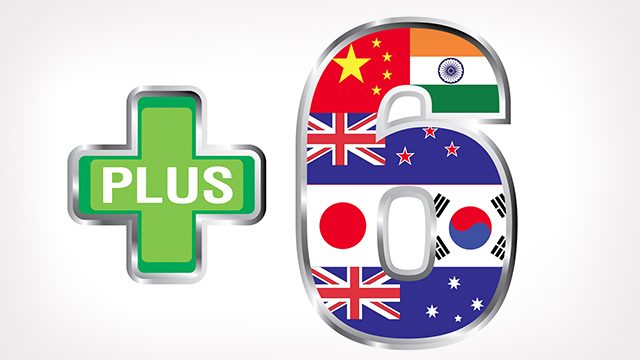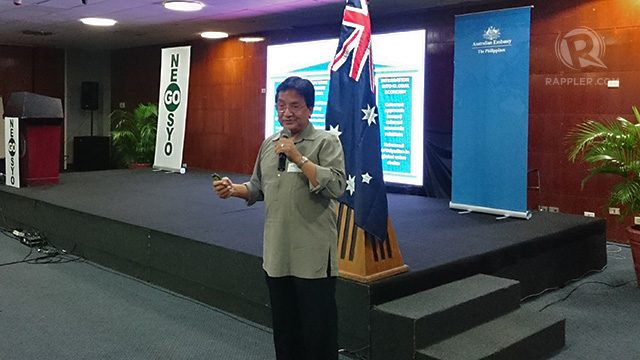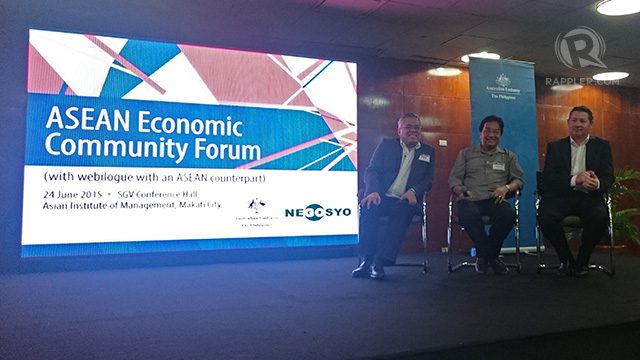SUMMARY
This is AI generated summarization, which may have errors. For context, always refer to the full article.

MANILA, Philippines – The ASEAN Economic Community (AEC) provides unprecedented access to trading opportunities not just between member partners but with regional countries powers as well.
“One little appreciated advantage of being with the AEC is that it grants automatic access to all these other trade dialogue partners which are all major economies” said Cielito Habito, head of USAID trade-related assistance, during the ASEAN Economic community forum jointly held by Go Negosyo and the Australian Embassy in Makati on Wednesday, June 24.
The Philippines has already had Free Trade Agreements (FTAs) with the 9 other members of ASEAN since 1992 with the establishment of the ASEAN Free Trade Area, but the ASEAN bloc has also negotiated free trade agreements with South Korea, Japan, Australia, New Zealand, China and India.
The FTAs with these 6 nations, in effect, turn a market for free trade with zero or preferential trade tariffs of 628 million people, ASEAN’s population, into a much wider regional market of around 3.45 billion people, roughly half the world’s population.
Trade shifting towards the east
ASEAN’s individual FTAs with these 6 nations are already beginning to have an effect on the Philippines’ trade.
“A little over a decade ago 60% of the Philippine’s trade was with the US, EU and the rest of the west. Now, 60% of our trade is with ASEAN and Asia,” shared Department of Trade and Industry (DTI) Industrial Development Undersecretary Adrian Cristobal Jr. in his keynote speech at the event.
Since the inception of the ASEAN-China free trade agreement in 2010, Philippine exports to China rose from $5.7 billion (P 257 billion) to $7 billion (P 315.8 billion) by 2013.
A factor in this has been the government’s active promotion of these FTAs, Cristobal explained.
“In 2010, we realized that not many have heard about these trade agreements. It was like a well-kept secret,” he said.
In order to promote them, the DTI launched a program that same year called “Doing Business in Free Trade Areas” which involved organizing seminars coaching entrepreneurs across the country on how to make the best use of these deals.
It has resulted in the Philippines having the highest increase in utilizing these FTAs in ASEAN and earning the country a special mention in ASEAN secretariat report for posting the highest increase in utilizing the ASEAN-Australia and New Zealand free trade agreement, Cristobal added.

Trade officials from ASEAN and the 6 countries are also currently in the process of pushing this further by combining the 6 individual free trade agreements to create just one single free trade area, Habito said.
The proposed Regional Comprehensive Economic Partnership (RCEP) would be world’s largest free trade area, accounting for about 1/3 of the world’s total gross domestic product (GDP).
Trade talks are targeted to be completed this year with the 6th and most recent meeting held in February of this year in Thailand.
Complementing not competing
Small, micro and medium enterprises (SMMEs) stand to benefit from this massive trade integration as global trading patterns have shifted towards intermediate products rather than completed goods.
“What is driving trade worldwide right now is in value chains, products being completed stage by stage and from country to country – things that are not yet finished products but will be turned into completed products somewhere else”, Habito said.
These are the kind of goods that the Philippines supplies a lot of, such as circuit boards and semi conductors, he added.
To illustrate this, he cited that the Philippines’ top 3 imports from Thailand are motor vehicles, electronics, petroleum, and chemicals, while the country’s top 3 exports are motor vehicle parts, electronics, and minerals.
“We’re importing and exporting products that are from the same industries so it’s not competitive trade, its complimentary trade, and it’s a similar pattern with Malaysia and Singapore,” Habito said.
When you look at the AEC, he explained, the opportunities lie in participating in these global value chains, and it is much easier for a small firm to focus on producing components in these chains rather than completed products.

Undue fear
“A lot of people are worried about a tsunami of ASEAN made products flooding the market and drowning domestic producers when the AEC is formally instituted on December 31, bringing with it a 100% removal of trade barriers between ASEAN nations,” Habito said.
In effect, AEC is already here with 99.6% of all tariff lines having been removed with the only remaining ones being rice and sugar due to political reasons, he explained.
The tariffs have been removed since 2010, he added, and since then local producers have managed just fine so there is no cause to worry.
“What we really need is a change in mindset, from fearing the threats to seizing the opportunities that AEC presents,” he said. – Rappler.com
(+6 image from Shutterstock)
$1 = P 45.12
Add a comment
How does this make you feel?
There are no comments yet. Add your comment to start the conversation.